Effect of fertility levels and biofertilizers on physical and chemical properties of soil under blackgram (Vigna mungo L.)
Bạn đang xem bản rút gọn của tài liệu. Xem và tải ngay bản đầy đủ của tài liệu tại đây (185.5 KB, 6 trang )
Int.J.Curr.Microbiol.App.Sci (2017) 6(3): 223-228
International Journal of Current Microbiology and Applied Sciences
ISSN: 2319-7706 Volume 6 Number 3 (2017) pp. 223-228
Journal homepage:
Original Research Article
/>
Effect of Fertility Levels and Biofertilizers on Physical and Chemical
Properties of Soil under Blackgram (Vigna mungo L.)
Chetan Kumar Jangir*, D.P. Singh, R.H. Meena and Mahendra Yadav
1
Maharana Pratap University of Agriculture and Technology, Udaipur, Rajasthan, 313001, India
2
Department of Soil Science, Rajasthan College of Agriculture, Udaipur, India
*Corresponding author
ABSTRACT
Keywords
Black gram,
Fertility,
Biofertilizers, Seed
inoculation, RDF.
Article Info
Accepted:
08 February 2017
Available Online:
10 March 2017
A field experiment was conducted at Institutional Farm, Rajasthan College of Agriculture,
Udaipur, (Rajasthan) during kharif, 2014 on clay loam soil. The experiment was laid out
according to factorial randomized block design with three replications. The experiment
comprised four fertility levels of (control, 50% RDF, 75% RDF, and 100 % RDF) and four
biofertiliizers levels (control, PSB, Rhizobium and Rhizobium + PSB) were applied to the
black gram var.T-9. The application of 100 % RDF and seed inoculation with Rhizobium +
PSB or combination significantly increased the organic carbon, available N, P 2O5, K2O,
Cu, Zn, Fe and Mn content in soil. However, bulk density, particle density, porosity, Ec
and pH was found non significant after harvesting of the crop due to above properties
don’t change in one cropping season.
Introduction
inoculation with Phosphate Solublizing
Bacteria (PSB) plays a pivotal role in
supplementary phosphorus requirement of
crop. PSB brings out more amount of fixed or
unavailable native phosphorus into soluble
and available form to the plants.
Black gram (Vigna mungo L.) originated
in India, contains 24 per cent protein, 60 per
cent carbohydrate, 1.3 per cent fat and
phosphoric acid. Black gram plays an
important role in maintaining and improving
the soil fertility through its ability to fix
atmospheric nitrogen in the soil through root
nodules which possesses Rhizobium bacteria.
In India, black gram is grown on 3.07 m ha
area with a production of 1.60 million metric
ton. In Rajasthan, pulses occupy 32.46 lac ha
area with a production of 19.57 lac ton.
However, productivity of black gram is low in
Rajasthan 575 kg ha-1 (Anonymous, 2012).
Rhizobium plays an important role in
increasing the availability of nitrogen to the
plants and helps in boosting the production
through nitrogen
fixation. Similarly,
Nitrogen plays important role in synthesis of
chlorophyll, amino acids and other organic
compounds of physiological significance in
plant system. Phosphorus role in root
development, nodule formation and plays
important role in energy transfer in the living
cells by means of high energy phosphate bond
of Adenosine Tri Phosphate.
There is evidence of stagnation or low
productivity of black gram and other kharif
223
Int.J.Curr.Microbiol.App.Sci (2017) 6(3): 223-228
pulses even with the application of
recommended doses of NPK fertilizers
(Athokpam et al., 2009). Due to low and
unstable production and increasing population
pressure, the per capita availability of pulses
has come down from 69 g in 1961 to about
39.4 g in 2011 against the minimum
requirement of 80 g capita-1 (Anonymous,
2012). In this research work was studied that
effect of fertility levels and biofertilizer levels
on physical and chemical properties of soil.
Results and Discussion
Materials and Methods
Chemical properties
The experiment was conducted at Institutional
Farm Rajasthan College of Agriculture,
Udaipur, which is situated at South-Eastern
part of Rajasthan at an altitude of 582.17
metre above mean sea level and at 24º 35 N
latitude and 73º 42 E longitude. The region
falls under Agro-climatic Zone IV a (Subhumid Southern Plain and Aravalli Hills) of
Rajasthan. The soil of experimental site was
clay loam in texture, slightly alkaline in
reaction. The soil was medium in available
nitrogen and phosphorus while high in
potassium, and sufficient in DTPA extractable
micronutrients.
The data summarized in (Table 2) revealed
that there was no significant variation in pH
and EC of black gram due to different fertility
levels and biofertilizers because pH and Ec do
not change significantly in one cropping
season (one reason).
Physical properties
A perusal of data (Table 2) revealed that there
was no significant variation in bulk density,
particle density and porosity of black gram
due to different fertility levels and
biofertilizers because physical properties do
not change significantly in one cropping
season.
The data presented in table 3 indicate that the
application of fertility levels under 50 %
RDF, 75 % RDF and 100 % RDF treatments
increased the organic carbon in soil after
harvest to the extent of 5.89, 22.56 and 25.76
per cent, respectively over control OC
(0.60%). Seed inoculation with PSB,
Rhizobium and Rhizobium + PSB increase in
organic carbon of soil after harvest was to the
extent of 6.29, 7.08 and 10.85 per cent
respectively, over control.
The experiment comprised four fertility levels
of (control, 50% RDF, 75% RDF, and 100 %
RDF) and four biofertiliizers levels (control,
PSB, Rhizobium and Rhizobium + PSB) were
applied to the black gram var.T-9. 30 kg ha-1
Phosphorus was applied through DAP and
nitrogen at 20 kgha-1 was applied through
urea after adjusting N supplied through DAP.
Available nitrogen, phosphorus, potassium
Effect of fertility levels
It is evident from the data summarized in
table 3 that after harvesting of the crop the
available nitrogen in soil the application of
fertility levels under control, 50 % RDF, 75 %
RDF and 100 % RDF treatments increased the
available nitrogen in soil to the extent of
259.46, 271.79, 298.18 and 303.60 kg ha-1
respectively. The application of fertility levels
under 50 % RDF, 75 % RDF and 100 % RDF
treatments after harvest of the crop increased
To assess the fertility status of soil, the soil
sample (0-15 cm depth), from each plot at
harvest of crop was taken. The samples were
passed through 2 mm plastic sieve to avoid
metallic contamination. The soil sample were
analysed for Soil texture, EC, pH, Bulk
density, Particle density and OC and available
NPK and cationic micronutrients (Cu, Zn, Fe,
Mn) content (Table 1).
224
Int.J.Curr.Microbiol.App.Sci (2017) 6(3): 223-228
the available phosphorus in soil to the extent
of 19.70, 21.87 and 22.33 kg ha-1
respectively, over control (19.12 kg ha-1).
PSB, Rhizobium and Rhizobium + PSB
inoculation was to the extent of 21.10, 21.26
and 22.30 kg ha-1, respectively over control
was 18.38 kg ha-1. The beneficial effect of
Rhizobium on root growth, development and
nodulation of black gram which led to more
N2 fixation, black gram being legume crop
which absorbed more soil nutrients from
subsurface layers to meet their requirement
and part of which was left in surface soil with
the root residues after harvest of the crop
decomposed and improved the soil fertility.
There was no significant variation in available
potassium of black gram due to different
fertility levels and biofertilizers.
Effect of biofertilizers
An examination of data in table 3 revealed
that the increase in available nitrogen with
Rhizobium + PSB was found to be significant
over Rhizobium as well as PSB inoculations.
The increase in available nitrogen in soil with
control, PSB, Rhizobium and Rhizobium +
PSB was to the extent of 259.25, 286.16,
287.40 and 300.22 kg ha-1 respectively. The
increase in available phosphorus in soil with
Table.1 Methods adopted for soil analysis
S. No.
(i)
(ii)
(iii)
(iv)
(v)
(vi)
(vii)
(viii)
(ix)
(x)
(xi)
Determinations
Soil texture
Soil reaction(pH)
Methods
By International Pipette Method
With the help of pH meter in 1:2
soil-water suspension
Electrical
EC of 1:2 soil-water suspension
conductivity (EC)
with the help of “solubridge”
Bulk density
Method No. 38 of USDA Hand
Book No. 60
Particle density
Method No. 39 of USDA Hand
Book No. 60
Porosity
Method No. 40 of USDA Hand
Book No. 60
Organic carbon
Determination by rapid titration
method
Available nitrogen
Estimation by alkaline potassium
permanganate method
Available
Olsen’s P, 0.5 M NaHCO3
phosphorus
method, pH 8.5
Available potassium Neutral
ammonium
acetate
extraction and Flame photometry
method
Available Zn, Fe, Cu Extraction by 0.005 M DTPA +
& Mn content
0.01 M CaCl2 + 0.1 M
triethanolamine at pH 7.3
225
Reference
Piper (1960)
Piper (1960)
Richards (1954)
Richards (1954)
Richards (1954)
Richards (1954)
Walkley and
Black
(1934)
Subbiah
and
Asija
(1956)
Olsen et al. (1954)
Richards (1954)
Lindsay
(1978)
and
Norvell
Int.J.Curr.Microbiol.App.Sci (2017) 6(3): 223-228
Table.2 Effect of fertility levels and biofertilizers on physical and chemical properties of soil
after crop harvest
Treatments
Fertility Levels
F0 : Control
F1 : 50 % RDF
F2 : 75 % RDF
F3 : 100 % RDF
SEm±
C.D. (P= 0.05)
Biofertlizers
B0: Control
B1 : PSB
B2:Rhizobium
B3:PSB+Rhizobium
SEm±
C.D.(P= 0.05)
Bulk
density
(Mg/m3)
Particle
density
(Mg/m3)
Porosity
(%)
EC
(dSm-1)
pH
1.36
1.35
1.31
1.29
0.04
NS
2.65
2.65
2.65
2.63
0.06
NS
48.67
49.05
50.56
50.95
0.10
NS
0.81
0.82
0.82
0.83
0.002
NS
8.13
8.21
8.32
8.50
0.07
NS
1.36
1.36
1.35
1.30
0.04
NS
2.64
2.63
2.63
2.61
0.06
NS
48.48
48.28
48.66
50.19
0.10
NS
0.81
0.82
0.82
0.82
0.002
NS
8.21
8.29
8.28
8.39
0.07
NS
Table.3 Effect of fertility levels and biofertilizers on chemical properties of soil after crop
harvest
Treatments
Fertility Levels
F0 : Control
F1 : 50 % RDF
F2 : 75 % RDF
F3 : 100 % RDF
SEm±
C.D. (P= 0.05)
Biofertlizers
B0: Control
B1 : PSB
B2 : Rhizobium
B3:PSB+Rhizobium
SEm±
C.D. (P= 0.05)
OC (%)
Available N
(kg ha-1)
Available P2O5
(kg ha-1)
Available K2O
(kg ha-1)
0.60
0.62
0.72
0.74
0.006
0.017
259.46
271.79
298.18
303.60
2.84
8.20
19.12
19.70
21.87
22.33
0.25
0.72
408.20
412.81
426.08
430.90
6.94
NS
0.63
0.68
0.68
0.71
0.006
0.017
259.25
286.16
287.40
300.22
2.84
8.20
18.38
21.10
21.26
22.30
0.25
0.72
403.42
421.62
423.91
429.03
6.94
NS
226
Int.J.Curr.Microbiol.App.Sci (2017) 6(3): 223-228
Table.4 Effect of fertility levels and biofertilizers on available micronutrients of soil after crop
harvest
Treatments
Fertility Levels
F0 : Control
F1 : 50 % RDF
F2 : 75 % RDF
F3 : 100 % RDF
SEm±
C.D. (P= 0.05)
Biofertlizers
B0: Control
B1 : PSB
B2 : Rhizobium
B3:PSB+Rhizobium
SEm±
C.D. (P= 0.05)
Available
Zn
(mg kg-1)
Available
Fe
(mg kg-1)
Available
Cu
(mg kg-1)
Available
Mn
(mg kg-1)
1.84
1.99
2.06
2.13
0.02
0.07
3.51
3.79
4.21
4.33
0.09
0.27
2.25
2.36
2.51
2.55
0.03
0.08
3.31
3.51
4.05
4.18
0.06
0.18
1.85
2.00
2.06
2.12
0.02
0.07
3.53
3.93
4.04
4.32
0.09
0.27
2.27
2.39
2.47
2.53
0.03
0.08
3.30
3.73
3.88
4.14
0.06
0.18
inoculation of black gram seed with PSB,
Rhizobium and Rhizobium + PSB significantly
increased available copper, zinc, iron and
manganese in soil comparison to control. The
seed inoculation with control (No seed
inoculation), PSB, Rhizobium and Rhizobium +
PSB significantly increase in available copper
(2.27, 2.39, 2.47 and 2.53 mg ha-1), zinc (1.85,
2.00, 2.06 and 2.12 mg ha-1), iron (3.53, 3.93,
4.04 and 4.32 mg ha-1) and manganese (3.30,
3.73, 3.88 and 4.14 mg ha-1) in soil,
respectively. An examination of data in table 4
revealed that the increase in available copper,
zinc, iron and manganese in soil of black gram
with Rhizobium + PSB was found to be
significant over Rhizobium as well as PSB
inoculations. However, the increase in available
copper, zinc, iron and manganese content in soil
with inoculation of Rhizobium was found to be
at par with that of PSB. Rhizobium and PSB
improve the N and P status of soil. Combined
inoculation of N2 fixers and PSB benefit the
plant than either group of organisms alone and
may have added advantage in the degraded agro
ecosystem. Dual inoculation might have
contributed something towards enhanced plant
growth and increased the soluble P. Increased
nodulation under Rhizobium + PSB inoculation
Available copper, zinc, iron and manganese
Effect of fertility levels
Further analysis of data (Table 4) revealed that
the application of fertility levels (Control, 50 %
RDF, 75 % RDF and 100 % RDF treatments)
after harvesting of the crop increased the
available copper (2.25, 2.36, 2.51 and 2.55 mg
ha-1), zinc (1.84, 1.99, 2.06 and 2.13 mg ha-1),
iron (3.51, 3.79, 4.21 and 4.33 mg ha-1) and
manganese (3.31, 3.51, 4.05 and 4.18 mg ha-1)
in soil, respectively. The increase in available
micronutrient content of soil with 100 % RDF
treatment was found to be at par with 75 %
RDF treatment. The data (Table 3 and 4)
showed that the 100% RDF had profound
influence on the organic carbon, available N, P,
K, Cu, Zn, Fe and Mn status of soil. All the
treatments resulted in increasing available
nutrient in soil over control. These results are in
agreement with those of Zhao et al., (2009),
Yadav and Kumar (2009), and Chesti and Ali
(2012).
Effect of biofertilizers
Further examination of data (Table 4) showed
that after harvesting of the crop due to
227
Int.J.Curr.Microbiol.App.Sci (2017) 6(3): 223-228
on growth, seed yield and economics of
field pea (Pisum sativum L.) and soil
fertility changes. J. Food Legumes, 25: 121124.
Lindsay, W.L. and Norvell, W.L. 1978.
Development of a DTPA soil test for Zn,
Fe, Mn and Cu. Soil Sci. Society and
American J., 42: 421-442.
Olsen, S.R., Cole, C.V., Watanable, F.S. and
Dean. L.A. 1954. Estimation of available
phosphorus in soil by extraction with
sodium bicarbonate. U.S.D.A, 939, USA.
Piper, C.S. 1960. Soil and Plant Analysis. The
University of Adelaide, Australia.
Richard, L.A. 1954. Diagnosis and improvement
of saline and alkaline soils. USDA, Hand
Book No. 60.
Singh, A., Singh, V.K., Chandra, R. and
Srivastava, P.C. 2012. Effect of integrated
nutrient management on pigeon pea based
intercropping system and soil properties in
mollisol of the tarai region. J. Indian
Society of Soil Sci., 60: 38-44.
Subbiah, B.V. and Asija, G.L. 1956. A rapid
procedure for the determination of available
nitrogen in soils. Curr. Sci., 25(7): 259-260.
Walkley and Black. 1947. Estimation of soil
organic carbon by the chromic acid titration
method. Soil Sci., 37: 29-38.
Yadav, D.S. and Kumar, A. 2009. Long term
effect of nutrient management on soil
health and productivity of rice (Oryza
sativa) - wheat (Triticum aestivum) system.
Indian J. Agronomy, 54: 15-23.
Zhao, Y., Wang, P., Ligianlong, Chen, Y., Ying,
X. and Liu, S. 2009. The effects of two
organic manures on soil properties and crop
yields on a temperate calcareous soil under
a wheat- maize cropping system. European
J. Agronomy, 31: 36-42.
might be to due to close association of both the
microbial population and their activities
resulting in improving soil fertility status. These
finding are similar to the results obtained by
Singh et al., (2012), Khandelwal et al., (2012)
and Kumari et al., (2012).
On the basis of one year field experimentation,
it can be concluded that under agro climatic
condition of zone IVa (Sub-humid Southern
Plain and Aravali Hills) of Rajasthan,
application of 100% RDF + Rhizobium + PSB
(F3B3), is the better option for realizing
improved fertility status of soil. However the
highest available nitrogen, phosphorus,
potassium, copper, zinc, iron and manganese
status of soil after harvesting of black gram crop
were observed under fertility level 100% RDF
(F3) and inoculation of Rhizobium + PSB (B3)
treatment as compared to 75% RDF (F2) and
control (B0) respectively. Adoption of
integrated nutrient management involving
(Inorganic
fertilizers
and
biofertilizers
application) through improves the soil health.
References
Chesti, M.H. and Ali, T. 2012. Rhizospheric
micro-flora, nutrient availability and yield
of green gram (Vigna radiata L.) as
influenced by organic manures, phosphate
solublizers and phosphorus levels in
Alfisols. J. Indian Society of Soil Sci., 60:
25-29.
Khandelwal, R. 2012. Response of cowpea [Vigna
unguiculata (L.)Walp] to nitrogen and
phosphorus
fertilizers
and
seed
inoculations. Legume Res., 35: 235-238.
Kumari, A., Singh, O.N. and Kumar, R. 2012.
Effect of integrated nutrient management
How to cite this article:
Chetan Kumar Jangir, D.P. Singh, R.H. Meena and Mahendra Yadav. 2017. Effect of Fertility Levels
and Biofertilizers on Physical and Chemical Properties of Soil under Blackgram (Vigna mungo L.).
Int.J.Curr.Microbiol.App.Sci. 6(3): 223-228.
doi: />
228
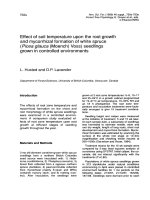

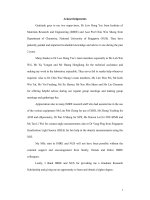
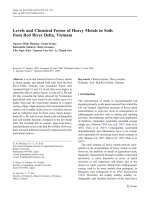
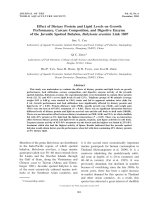
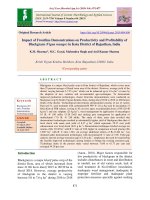


![Effect of fertility levels and stress mitigating chemicals on nutrient uptake, yield and quality of mungbean [Vigna radiata (L.) Wilczek] under loamy sand soil of Rajasthan](https://media.store123doc.com/images/document/2020_01/09/medium_ftp1578562755.jpg)
![Generation mean analysis for yield, yield components and MYMV disease scores in blackgram [Vigna mungo (L).Hepper]](https://media.store123doc.com/images/document/2020_01/09/medium_kiu1578565010.jpg)